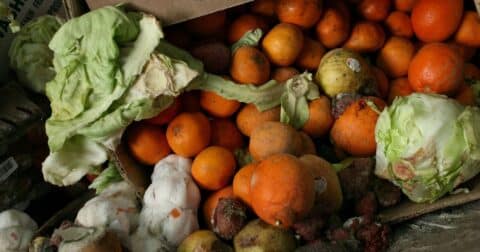Explainer
Agriculture Affects Deforestation Much More Than Most People Realize
Climate•7 min read
Solutions
Food waste is responsible for 6 percent of U.S. climate emissions. Upcycling is one solution.


Words by Julieta Cardenas
“Food isn’t waste until we waste it,” said Jonathan Deutsch, founding director of the Drexel Food Lab, at a panel during the Plant Based World Expo held last month in New York City. At Drexel University, students work with startup companies to “upcycle” food waste — taking ingredients that might otherwise have ended up in a landfill and turning them into food.
Food waste continues to be a significant problem. Globally, a third of all food produced is wasted, or roughly 1.3 billion tons per year. In the U.S., food waste generates 170 million metric tons of carbon dioxide equivalent each year, around the same emissions as 42 coal-fired power plants, or 6 percent of all U.S. greenhouse gas emissions. And just like climate change itself, there isn’t a single solution. According to the EPA, the best option is to “produce, buy and serve only what’s needed,” but the next best solution is to donate or “upcycle” food that would otherwise be wasted, which is where initiatives like the one at Drexel University come in to play.
Upcycled foods are foods made with ingredients that would otherwise end up as food waste. The idea is not new to the culinary arts or to food science, says Deutsch, who is also trained as a research chef, someone who oversees the research and development of new food products. “It’s been happening as long as there’s been sausage and pickles,” he says.
What’s new now is that consumers are paying attention. Food companies didn’t always want to highlight their use of “rescued” ingredients, Deutsch says, as “the conventional wisdom of the industry was that we don’t want to be transparent with consumers.” That began to change around 2019, as a wave of companies found success touting their “ugly” and “rescued” fruit and vegetables (a trend that is not without criticism).
The Upcycled Foods Association also launched officially in 2019, one of its co-founders, Caroline Cotto, tells Sentient. The upcycling label, which was created by the Upcycled Foods Association, is now overseen by Where Food Comes From, a third party independent verifier of a range of labels, including the certified organic label. The upcycled label is not regulated by the government the way that the organic label is, but the association convened stakeholders from Harvard, World Wildlife Federation, the National Resources Defense Council and ReFed to come to an agreement on a definition.
To earn the upcycled label, products must be made from at least 10 percent upcycled ingredients by weight which could be a limitation. The upcycling label requires that companies provide auditable proof that they are using products that would have otherwise ended up in a landfill, Cotto told Sentient in an email.
A number of startups are working on upcycled products. Take for example Reveal Avocado Brew, a tangy tea made from avocado pits that are rich in antioxidants. According to the company, 15 million pounds of avocado seeds are thrown into landfill each year. While the carbon footprint of avocados is a fraction of meat, especially beef, every bit of waste averted helps to some degree. The avocado pits are saved by participating restaurants including Tacombi in New York and Rosy’s Taco Bar in Philadelphia. They are then cleaned and processed at the Rutgers Food Innovation Center.
Another product, TBJ gourmet’s bacon jam, is made from the trimmings of smoked pork belly that could potentially end up tossed into the trash. When the company started, they saw bacon ends being used for hotdogs and bacon bits toppings, TBJ Gourmet cofounder Mike Oraschewsky said in an email to Sentient, so they were keen to come up with another rescued use. One in four farm animals raised for food ends up wasted, which means there are emissions released to produce the meat, and emissions released when the meat hits landfill and breaks down.
“Meat is our most carbon intensive category in terms of environmental impact, along with dairy,” says Deutsch. “If we’re going to have carbon intensive products in our diet, we want to make sure that we’re using all these foods and not letting them go to waste.” So far 350,000 lbs of pork belly has been upcycled by TBJ gourmet, according to the company’s tracking.
Other Upcycled Food Association members include Matriark foods, which makes upcycled vegetable broth and tomato sauce, some of which are served in corporate kitchens like the Google offices and Barclays Center. Each carton of Matriark upcycled broth saves 102 gallons of water, and nearly a pound of what would be wasted food, according to the company’s own accounting.
“The goal should be to get producers to use as much as they can,” says Cotto, who serves on the board at the Upcycled Foods Association. “There’s a company called Hyfé foods that’s taking leftover beet stems and pulp from the sugar beet industry, and upcycling that into lower cost feedstock for fermentation and biofuel processing.” Some non-edible things in food processing cannot be consumed, says Cotto, “but for the most part, there are creative ways to upcycle most food byproducts while still maintaining food safety of the products.”
In the U.S., around two thirds of food waste is essentially food left uneaten, rather than crops left on the field. The U.S. food system is highly efficient, with a range of secondary markets for misshapen produce. Farmers can easily sell ugly tomatoes to salsa companies or bruised apples to applesauce makers, for instance.
Yet at home, Americans waste an estimated 6.2 cups of food every week per household. Drexel Food Lab is working on this problem too however, with help from an EPA grant to create a cooking class for home cooks. The goal of the class, says Deutsch, is to teach home cooks “the same culinary techniques that chefs use to upcycle and reduce waste, and apply it to home kitchens.”